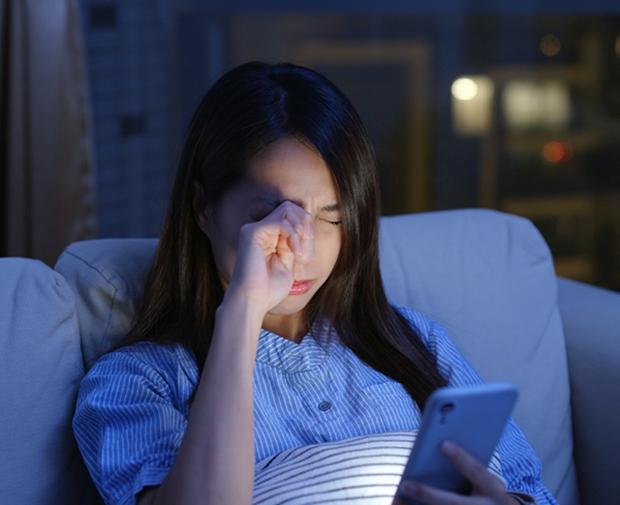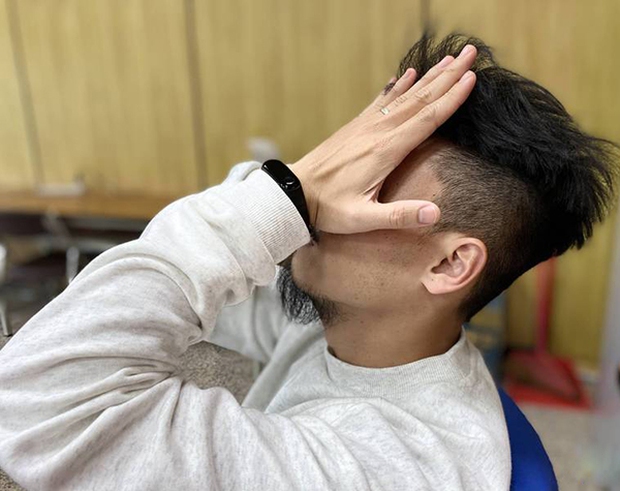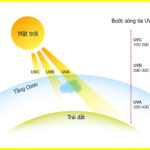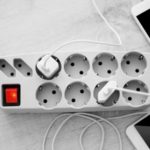The advancement of technology has changed our lifestyle and made electronic devices an essential part of our daily habits. Especially during the Tet holiday, when we have more free time, the usage of electronic devices also increases. This means that we are exposed to harmful blue light more often.
How does blue light harm our eyes?
Blue light is commonly defined as visible light with wavelengths ranging from 380 to 500nm, which is close to the ultraviolet (UV) rays on the spectrum. Blue light is sometimes broken down into blue-violet light (about 380 to 450nm) and blue-turquoise light (about 450 to 500nm). It is present in sunlight and mainly emitted by electronic devices such as phones, computers, TVs, game consoles… or LED and fluorescent lights.

During the Tet holiday, with more free time, we have a higher exposure to blue light from electronic devices (Illustration)
Blue light has many harmful effects on human health, especially on the eyes. Due to its short wavelength, blue light carries high energy and can penetrate deep into the eye, causing damage to the cells. Prolonged exposure can lead to the following consequences:
– Dry eyes, eye fatigue.
– Computer vision syndrome with symptoms of eye strain, blurred vision, headaches, dizziness, and loss of concentration.
– Increased risk of macular degeneration, cataracts, and glaucoma.
– Causing refractive errors such as nearsightedness and farsightedness.
– Decreased visual acuity, and even blindness.
– Excessive exposure to blue light can also disrupt the circadian rhythm and sleep, increasing the risk of eye-related diseases. For example, obesity, diabetes, cardiovascular diseases…
In addition, blue light also harms the skin, increases the risk of depression, and is a contributing factor to certain types of hormone-related cancers like breast and prostate cancer.
5 tips to minimize the harmful effects of blue light on the eyes
Of course, we cannot completely eliminate electronic devices or cut out blue light from our daily lives, especially during the upcoming Tet holiday. Instead, we should try to control our exposure to blue light and take advantage of the following 5 tips to mitigate its harmful effects on our eyes:
Maintain a safe distance and good posture when using electronic devices
Excessive exposure to blue light from the screen at a close distance for a long time can negatively impact eye health. Not only the eyes but also your skin can be affected and prone to premature aging. Therefore, to protect your eyes, healthcare professionals recommend keeping your phone and laptop at a distance of 30 to 50cm from your eyes.
At the same time, sitting in the proper position and looking straight at the device instead of tilting your head down or up can also greatly help protect your eyes from blue light.
Adjust the screen display settings of electronic devices
To counter the impact of blue light, adjusting the display settings of electronic devices can be very effective. First, adjust the brightness of the screen to an appropriate level. By setting the screen brightness at a suitable level, we can reduce eye fatigue. As a general rule, the screen brightness should match the surrounding lighting conditions. For example, dimming the screen in a low-light environment will prevent excessive contrast and reduce eye fatigue.
Second, you can adjust the color temperature, which refers to the warmth or coolness of the display’s colors. Adjusting the color temperature can play an important role in reducing exposure to blue light. Switching the screen to a warmer color temperature will reduce the emission of blue light, resulting in a more eye-friendly screen.
Alternatively, you can use pre-installed eye protection or night mode display settings, although not all electronic devices have this feature. Furthermore, never turn off the lights and use electronic devices to minimize the harmful effects of blue light on the skin and eyes at night.
Take regular breaks and exercise your eyes
According to eye care experts, following the 20-20-20 rule when using electronic devices is essential to protect your eyes. This means that every 20 minutes, you should take a 20-second break and focus on something at least 20 feet (about 6 meters) away. This helps prevent eye strain, allows your eyes to rest and recover properly, reduces eye fatigue, and protects your visual system.

Give your eyes a rest and regularly exercise them to have healthy and beautiful eyes (Illustration)
In addition, you can take advantage of your free time to exercise your eyes with various exercises. For example, continuous blinking for 2 minutes, keeping your head straight and moving your eyes from left to right and vice versa 10-20 times on each side, closing your eyes and moving your eyeballs vertically, rotating your eyeballs in a clockwise and counterclockwise motion 10-20 times in each direction, combining near and far focus continuously for 1 minute, or writing with your eyes. You can also gently massage your temples and the area around your eyes. Of course, you can combine multiple exercises at once.
Use blue light-blocking glasses and eye drops
Nowadays, there are many types of blue light-blocking glasses available for us to “coexist” with electronic devices, LED lights, etc., without causing too much harm to our eyes. Essentially, these glasses are equipped with special lenses that absorb and reflect a significant amount of blue light, protecting the eyes from potential harm.
Similarly, using eye drops properly can also minimize the harmful effects of blue light on the eyes. Especially in reducing the symptoms of digital eye strain, including dryness, blurred vision, and headaches. By creating a protective barrier on the surface of the eyes, eye drops prevent the intrusion of blue light into the delicate eye tissues. According to eye care experts, the most important component to look for when choosing eye drops to combat blue light is lutein.
However, whether it is blue light-blocking glasses or eye drops, it is recommended to purchase them from reputable sources, preferably with the advice of a doctor.
Adjust your diet
During the Tet holiday, we often have the habit of indulging in our favorite foods. But if you want to protect your eyes from blue light, there are some considerations to keep in mind. The most important is to supplement your diet with nutrients for healthier eyes.
You should include foods rich in lutein, vitamin A, vitamin C, vitamin E, vitamin B, antioxidant-rich foods, omega-3 fatty acids, zinc, etc. By adding vegetables, beetroots, bell peppers, nuts, eggs, salmon, sweet potatoes, carrots, etc. to your daily menu.

Supplementing your diet with good nutrients for the eyes helps to have healthier eyes (Illustration)
Additionally, you should limit the consumption of stimulants such as alcohol or tobacco. Stay hydrated and try to go to bed early, getting enough sleep for your eyes to rest.
Source: Phụ nữ Việt Nam
Uncovering the Benefits of Eye Massage: 3 Unexpected Effects
Do you want to know how to protect your eyes and eyesight with simple massage techniques? Recent research has revealed that daily eye massage can provide a number of unexpected benefits to those looking to maintain healthy eyes and vision. Keep reading to find out more about the effects of eye massage and some simple exercises!





































